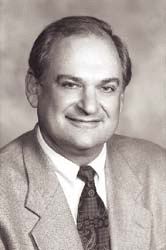ORLANDO, FL-New endoscopic technology allows skilled surgeons to perform minimally invasive operations such as delicate esthesioneuroblastoma resection-but a leader in the field suggests that just because the procedure can be performed endoscopically doesn’t necessarily mean it should be attempted.
Explore This Issue
July 2008Before endoscopic surgeons declare that the procedure is ready for prime time, Paul A. Levine, MD, the Robert W. Cantrell Professor of Otolaryngology-Head and Neck Surgery and Director of Head and Neck Surgical Oncology in the Department of Otolaryngology-Head and Neck Surgery at the University of Virginia in Charlottesville, said that doctors have to follow the example of famed surgeon Joseph Ogura, MD, by making sure their work conforms to precise scientific and medical and oncologic principles.
Dr. Levine, in delivering the Triological Society Joseph Ogura Lecture at the society’s 111th annual meeting, held during the Combined Otolaryngology Spring Meeting, said these principles include the following:
The doctor-patient relationship, more than ever before, must be based on a mutual trust and understanding to determine a therapeutic decision…. Honesty and integrity are imperative in discussing any therapeutic options, but especially for those options which have not been tested thoroughly enough to support a change from established therapy.
Cancer treatment should be performed by cancer specialists in cancer hospitals where all facilities and support staff are available.
Those who embark upon new treatments must be sure these treatments are based upon solid clinical principles, and reporting outcomes, good or bad, is crucial.
Dr. Levine said that endorsement of endoscopic resection of esthesioneuroblastomas should be withheld until the procedure has secured the long-term results that indicate that the procedure does indeed offer cure rates as high as those achieved with craniofacial resection.
Those of us who have had success in the treatment of esthesioneuroblastoma by performing craniofacial resection agree that this surgery remains the gold standard for treating esthesioneuroblastomas, Dr. Levine said. A review of the outcomes of craniofacial resection of esthesioneuroblastomas show how far we have come in the management of nasal vault malignancies.
The Business of Medicine
He said that the onus to perform minimally invasive endoscopic procedures is fed by the proliferation of a new generation of tools that are pushed by marketing that is part of the business of medicine.
It is clear that the practice of medicine is becoming a business-and a very big one, at that, Dr. Levine said. In terms of dollars spent, health care is the number-one industry in the United States. Individual physicians sometimes reflect this by purchasing and marketing the use of very expensive technological devices-occasionally prior to the approval of the newer technology.
Disease-Free Survival Rates
Dr. Levine demonstrated that the University of Virginia protocol-radiation followed by craniofacial resection and adjunctive chemotherapy based on Kadish staging-has produced impressive disease-free and overall survival practice results.

Leave a Reply